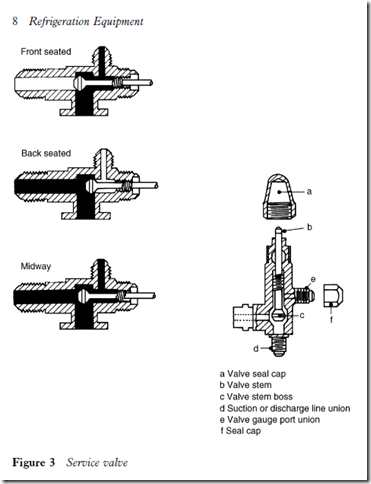System service valves
When servicing or commissioning any equipment it is necessary to record the system pressures by fitting pressure gauges. To make this possible, all commercial systems generally include at least three service valves: suction, discharge and liquid shut-off.
Suction and discharge service valves may be located on the compressor body of both reciprocating open-type compressors and semi-hermetic motor compressors, but on some compressor designs the service valves may be an integral part of the compressor head assembly. Hermetic motor compressors and some semi-hermetic models do not feature a discharge service valve, but the high side pressure may be obtained from the service valve on the liquid receiver or via a Schraeder-type valve fitted into the discharge line or on the receiver itself.
Service valves can be set to three different positions (Figure 3):
Front seated position The valve stem is turned fully clockwise to effectively stop the flow of refrigerant vapour from the suction line union on the low pressure side of the compressor and to the discharge line union on the high pressure side of the compressor.
Back seated position The valve stem is turned fully counter-clockwise to stop the flow of refrigerant vapour to the gauge port of the service valve.
Midway position The valve stem is turned either clockwise or counter- clockwise to leave the valve unseated. Thus refrigerant vapour can flow from the suction line and also to the discharge line and at the same time pass through the gauge port, to the gauge hose and to the relevant pressure gauge.
The liquid shut-off valve may be located at the outlet of the receiver. It is a single seating valve, i.e. it is either open or closed (Figure 4). On systems which do not have a receiver the valve design will be similar to that of a suction or discharge service valve and will have a gauge connection. When closed or fully front seated, this valve will stop the flow of liquid refrigerant from the condenser or receiver to the expansion device.
Performing service operations, carrying out repairs, commissioning a system and diagnosing faults involve the use of these valves in addition to test equipment, which will be dealt with separately.
Related posts:
Incoming search terms:
- a c service valves
- liquid receiver service valve
- service valve hvac
- ac service valve positions
- service valve
- Refrigeration Heat Exchange Equipment mail
- suction service valve repair
- old type of refrigation valves
- back seated valve
- backseat suction discharge
- how do service valves work
- service valve positions
- proper valve operation service
- A suction service valve connects to the suction line and directly onto the ____
- what type of service valve on a goodman gsx 14
- Compressors Lighting Commercial Spindle Repair Services mail
- diagram of a service valve
- Jochiwon Refrigeration Heat Exchange Equipment mail
- trane Discharge Valves
- service valve refrigeration
- refrigeration suction service valve
- operation of a hvac service valve
- hvac service valves and front seating valves
- a c service valve operation
- engine vaves mail
- 3 position service valve
- 2000 stoughton service valve
- service valve operation
- hvac service valve
- residential a/c service valve operation
- what is a service valve
- what is service valve
- back seated refrigerant valve
- hvac valves
- compressor service valve
- condenser service valve
- types of hvac service valves
- carrier central air conditioner service valve location
- ac service valve toolFOR BRIANT CONDENSER
- gauges in Sherman Texas mail
- Hermetic Canned Motor Pump mail
- High-altitude operation truck mail
- closing service valves refrigeration
- ac service valves operation
- Compressor service valves
- compressor suction and discharge service valve
- compressor suction valve
- Compressor Valves loc:US
- compression service valves
- why do you need to shut the system off before removing the gauge manifold from the liquid line service valve?
